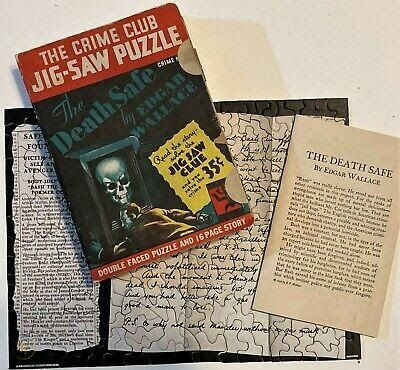Einson-Freeman published three jig-saw puzzles for The Crime Club in 1933. Each puzzle consisted of 200 pieces and offered an engaging challenge for fans of crime-themed puzzles. These crime-themed puzzles were designed to provide both entertainment and mental stimulation for puzzle enthusiasts. As puzzlers assembled the pieces, they engaged in a visual exploration of crime-related scenarios, allowing them to immerse themselves in the mystery and use their problem-solving skills to solve the puzzles.
All three puzzles were based on new 16-page short stories written by Edgar Wallace, specifically for these puzzles:
- The Death Safe by Edgar Wallace
- The Torch Murder by Edgar Wallace
- The Ringer's Revenge by Edgar Wallace
The original cost of each puzzle was 35 cents.
These three jig-saw puzzles were officially connected to The Crime Club by Doubleday in the USA, and featured the Crime Club gunman logo on the front and spine of each book-shaped box.
Crime Club Jig-Saw Puzzle #1
The Death Safe, by Edgar Wallace
The 16-page booklet of The Death Safe begins,
"Bash" was really clever. He stood out from all the other criminals in this respect. For the ranks of wrongdoers are made up of mental deficients--stupid men who invent nothing but lies. They are what the brilliant Mr. Coe calls in American criminals "jail bugs." The English criminal, because he does not dope, becomes a pitiable adn whining creature who demands charity, and the American criminal develops into a potential homicide.
Bash was a constant, but not, in the eyes of the law, an habitual criminal. He had never been charged because he had never been caught. He was an expert safe-breakers and worked alone.
Here is the copy from the back of the box:
Crime Club Jig-Saw Puzzle #2
Crime Club Jig-Saw Puzzle #3
THE CRIME CLUB
JIG-SAW PUZZLEWhat was the secret of "THE DEATH SAFE?"
WHAT deadly thing lurked within?
WHO was "The Ringer", mysterious avenger of crime?
WHY did he kill "Bash the Brutal"?
HOW did "Mr. Bash" meet his fate?
READ--
The thrilling 16-page story by EDGAR WALLACE--King of Mystery-story writers--most widely read author of "thrillers" in the world, then--
SOLVE--
The double-sided, 200 piece jig-saw puzzle--really TWO puzzles of 200 pieces each.
FIRST--put together the CLUE side--the torn letter and newspaper clipping. THEN put together the PICTURE side--in green and black--and you will
SOLVE THE CRIME!
CC-1 © 1933, EINSON-FREEMAN COMPANY, INC. Publishers, LONG ISLAND CITY, N.Y. LITHO IN U.S.A. Distributed by THE AMERICAN NEWS COMPANY, INC
Side 1 of The Death Safe
Side 2 of The Death Safe
Bookshelf Format
One of the clever parts of these puzzles was that they were shaped like books, and fit perfectly on a bookshelf alongside your collection of the books by The Crime Club.
Crime Club Jig-Saw Puzzle #2
The Torch Murder, by Edgar Wallace
A new 16-page story by Edgar Wallace, written specifically for this jig-saw puzzle format. The solution is only found when the jig-saw puzzle is completed.
All three of The Crime Club jig-saw puzzles were written by Edgar Wallace, so this one is not to be confused with The Torch Murder by Charles Read Jones, published by Dutton Clue Mystery in 1930.
Here's a review, written in April 1933 by Walter D. Hickman in The Book Nook:
The back of the box, booklet, and a few pieces of the double-sided puzzle:
Crime Club Jig-Saw Puzzle #3
The Ringer's Revenge, by Edgar Wallace
Another new story by Edgar Wallace specifically for this jig-saw puzzle format, based on his famous character, The Ringer.
.jpg) |
| The Ringer's Revenge, jig-saw puzzle by Edgar Wallace |
 |
| The Ringer's Revenge, completed puzzle |
Warning! Crime Club puzzlers never tell!
In each puzzle, a card was included that warned puzzlers not to give away the solution.
Don't give away the solution —but, after you have solved the crime yourself, you can play the amusing party game of "MURDER!"
When the party is all together, tell them just the outline of the mystery. Then send out one member of the party while you tell the rest the solution. When the one sent out returns, he should try to guess it by putting a series of questions to the others, the answer to which is "Yes" or "No."








.jpg)

.jpg)
.jpg)
.jpg)
.jpg)